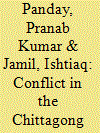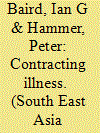| Srl | Item |
| 1 |
ID:
181069


|
|
|
|
|
| Summary/Abstract |
On March 4, 2020, members of India’s indigenous communities, known as Adivasis (i.e., original inhabitants), gathered at Jantar Mantar—an iconic protest site in New Delhi—to register their objections against the Citizenship Amendment Act–National Register of Citizens–National Population Register (CAA–NRC–NPR). The protesters, who came from different parts of India, opposed them mainly on three grounds.
First, they were concerned that a large segment of Adivasis may not be able to prove their citizenship due to the lack of identification documents and, therefore, could lose their citizenship.
|
|
|
|
|
|
|
|
|
|
|
|
|
|
|
|
| 2 |
ID:
093189


|
|
|
| 3 |
ID:
128886


|
|
|
|
|
| Publication |
2013.
|
| Summary/Abstract |
Without much attention to local context, global health policy experiments are being conducted on vulnerable indigenous populations. This article details the history of a development-bank-funded experiment to contract out public health services in Cambodia's north-eastern province of Ratanakiri. The case study highlights the difficulties that flow from improper planning and implementation, as well as the distorting effects that narrowly defined contract performance measures can have on the health of the population as a whole. Progress in global health will not be possible if local context and voices continue to be underappreciated.
|
|
|
|
|
|
|
|
|
|
|
|
|
|
|
|
| 4 |
ID:
190906


|
|
|
|
|
| Summary/Abstract |
This paper develops an account of the relationship between language endangerment and conflict violence by combining insights from the fields of political science and linguistics. We develop a theoretical account of the manner in which the violence and disruption of community life jeopardizes the viability of communities that speak endangered languages. Our goals for this paper are to synthesize the contributions linguists and political scientists have made to the study of language endangerment and political violence; develop a theoretical account of language endangerment; and utilize statistical analysis to correlate factors related to political conflict and violence with language endangered communities. We test our theoretical model on language endangerment across the municipalities of Colombia and find support for our hypotheses.
|
|
|
|
|
|
|
|
|
|
|
|
|
|
|
|
| 5 |
ID:
173881


|
|
|
|
|
| Summary/Abstract |
The Nasa indigenous group’s Guardia Indígena, whose primary goal is to protect indigenous people and their territories from all types of armed groups, is a nonviolent self-protection organization in Northern Cauca, Colombia. On 5 November 2014, while peace talks were ongoing between the Revolutionary Armed Forces of Colombia (FARC) and the Colombian government, two Guardia Indígena members were shot dead by FARC guerrillas. Without guns or physical violence, indigenous guards captured seven guerrillas responsible for the crime, and, four days later, indigenous organizations held a trial and sentenced the rebels to imprisonment. This article describes those events and investigates how the unarmed guards managed to capture the guerrillas and bring them to trial. The self-organization concept is used to gain insights into the mechanisms and strategies deployed. The mechanisms of the Guardia Indígena include constructing and applying specific social norms and values, developing a common goal, and applying a flexible mix of centralized and decentralized ways of organizing. By combining and activating these mechanisms at carefully chosen moments, indigenous people have succeeded in organizing themselves as a collective movement that is powerful enough to confront armed groups without using violence.
|
|
|
|
|
|
|
|
|
|
|
|
|
|
|
|